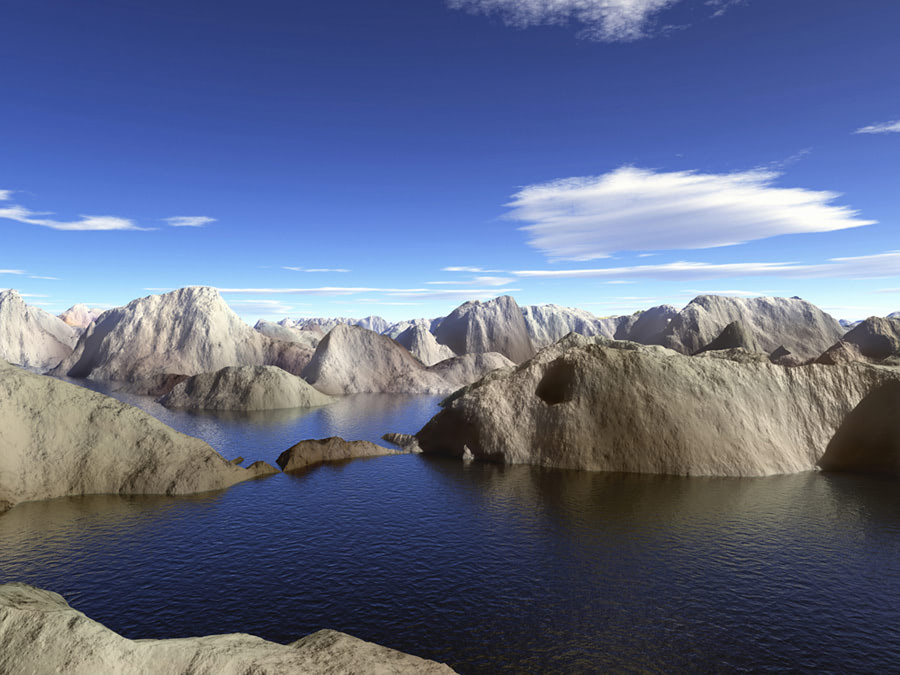Quoted in a recent interview about his work, Landscapes without Memory, artist Joan Fontcuberta asked, “Could a natural nature exist? The answer is no, or at least, not anymore: man’s presence makes nature artificial.”
Often concerned with the ambiguity of truth, reality and virtuality Fontcuberta’s latest exhibition at photogallery Foam in Amsterdam consists of an expansive series of dramatic 3D landscapes. On first glance the images resemble something like eerie, almost empty Lord of the Rings stills. These aren't photos but rather images produced by Fontcuberta using software developed for the U.S Air Force.
Originally cartographical data was fed into the programme to produce 3D landscape images, Fontcuberta however, fed the programme visual data - images from great masters like Gauguin, Van Gogh, Cezanne and Turner - producing entirely unique 3D landscapes. (The image above was originally a Pollock). “The representation of nature no longer depends on the direct experience of reality, but on the interpretation of previous images, on representations that already exist. Reality does not precede our experience, but instead it results from intellectual construction.”
Well known for his mischievous sense of humour and blurring the line between truth and fiction Next Nature asked Fontcuberta: can we trust what Wikipedia says about you?
Wikipedia: Joan Fontcuberta (born February 24, 1955 in Barcelona, Catalonia, Spain) is a conceptual artist whose best-known works, such as Fauna and Sputnik, examine the truthfulness of photography. In addition, he is a writer, editor, teacher, and curator.
Joan: Yes, I feel comfortable with such profile.
Wikipedia: Fontcuberta describes himself as "self-taught in photography" and considers himself "a conceptual artist using photography”.
Joan: I was self-taught in photography because when I started in the early 70s there were no schools or university programs devoted to photography, so everything should be done on your own. I consider myself a conceptual artist in the sense that the theoretical or ideological insight guides the aesthetic values.
Wikipedia: [On Dr. Ameisenhaufen's Fauna (1987)] Fontcuberta reported that responses to the exhibition ranged "from people who understand that it is a farce and appreciate the satire and the humor of it, to people who understand it's a farce and are angry at you for trying to fool them, to people who believe it and are angry, to people who believe it and are delighted."
Joan: All kinds of reactions are welcome. I don't try to fool the viewers; I provide always the necessary clues to unveil the forgery –although it might take time and attention... I am concerned with critical doubt, which I try to disseminate. But some people feel anxious with uncertainty.
Wikipedia: [On Sputnik (1997)] Among other reactions to the exhibition, a Russian ambassador "got extremely angry because [Fontcuberta] was insulting the glorious Russian past and threatened to present a diplomatic complaint."
Joan: That was a great situation and I tried to document it in order to implement the project itself. Information is my matter; so all forms of information generated by my projects become part of the project.
Wikipedia: [On Orogenesis (2002)] One review noted that the series suggests a "crisis in contemporary landscape art... Along with Googlegrams, the Orogenesis series was said to "call into question the boundaries of representation in the information age."
Joan: I am interested in language problems and more specifically in how facts are translated into signs. Both Googlegrams and Orogenesis deals with the conflicts and paradoxes of representation: images transformed into other images.
Next Nature: Do you edit your Wikipedia profile?
Joan: No, I have no idea who does.
Landscapes without Memory is on display at the photogallery Foam in Amsterdam until 27 February 2011.
Image: Orogenesis: Pollock, 2002 © Joan Fontcuberta

Share your thoughts and join the technology debate!
Be the first to comment